America’s Second “Redemption”
There have been two long marches to Reconstruction in American history—and two swift, brutal backlashes. We are in the middle of the second.
I haven’t been posting as frequently this year as I had been because I’m working through a series of pieces that I hope will provide more perspective on where we are now—how we got here and how we go forward from here. I posted the first of those pieces, “The Courts Will Not Save Us,” earlier this month (which was summarized in The Contrarian, and which I discussed on this podcast). This piece continues that analysis by making clear that the accelerating MAGA assault on the freedoms which, until just a month ago, too many took for granted, actually echoes a similar backlash a bit more than a century ago.
The Courts: Two Things Are True
In “The Courts Will Not Save Us,” I described how we effectively have two federal court systems. One, which I call Rule-by-Fiat, consists of judges and justices installed by and loyal to the Federalist Society, which reliably accomplishes outcomes that favor specific interests. Once cases reach the Rule-by-Fiat system, outcomes follow power relations rather than legal principles. (At SCOTUS, when Roberts sides with Kagan, Sotomayor, and Jackson, it is because there is division in the FedSoc coalition, usually between the corporate and theocratic wings.) The other system, which I call Rule-of-Law (distinct from the typical definition of “rule of law”), consists of the other federal judges and justices who continue the good-faith practice of adhering to democratic legal principles. Remember, in the Rule-of-Law system, Trump lost every major case; in the Rule-of-Fiat system he won them all.
Over the last six weeks, we have seen incredibly important victories in the Rule-of-Law judiciary—and for that, we must honor the courage and effectiveness of those putting themselves in Trump’s cross-hairs like Norm Eisen and Marc Elias, as well as their organizations (State Democracy Defenders Action, Democracy Docket), and others including the ACLU, Democracy Forward, and Public Citizen. You can keep up with the status of all the cases here. We know from other times and places how essential it is to slow down authoritarian blitzkriegs. They are American heroes.
But … we also have to be clear-eyed that the Trump Administration will (1) appeal their defeats to the Rule-by-Fiat Roberts Court, (2) likely pack the federal judiciary with another 200 loyalists like Matthew Kaczmaryk and Aileen Cannon so that by 2028 we can expect that a majority of the nation’s appeals courts will have Trump appointed majorities, and (3) likely swap in young loyalists to replace Thomas and Alito, locking in a SCOTUS majority of Federalist Society/MAGA justices.
Therefore, we must understand that today’s appeals to the judicial system are both absolutely essential and absolutely insufficient. The democratic deficit in the federal judiciary is hardly sudden or easily reversible, which means we cannot rely on the judicial system to make up that deficit. Instead, as I argued in “The Courts Will Not Save Us,” we must reclaim the agency of popular constitutionalism(wherein the meaning of the Constitution is legible to all and shaped by the public), and reject the learned helplessness of judicial supremacy (wherein the Supreme Court is always the final arbiter of constitutional meaning).
The Second “Redemption”
We recently honored the 60th anniversary of “Bloody Sunday,” when civil rights activists, including John Lewis, were brutally beaten upon attempting to cross the Edmund Pettus Bridge in Selma, Alabama to begin their march to Montgomery for voting rights.
In an essential way, “marching” is a perfect illustration of popular constitutionalism, and sharpens the difference between it and judicial supremacy. A march, after all, requires mass participation, and is by definition an intentional journey with the purpose of rallying even larger numbers to its cause. Through that purposefulness, a march demonstrates a democratic legitimacy far superior to the esoterica of usual jurisprudence. And marches take place outdoors, where all can see, not in closed chambers reserved for technocratic legal elites.
There have been two long marches to Reconstruction in American history. The first Reconstruction was codified in the 13th, 14th and 15th Amendments, and the second Reconstruction was codified in the Civil Rights and Voting Rights Acts, both of which immediately and dramatically broke down the barriers to Black political participation.
There have also been two swift, brutal regional backlashes to those long marches, when both judicial and extrajudicial actors stoked the infernal wildfires of white grievance. And both of those were followed by national “redemptions,” where many elements of the regional “redemptions” were extended to the nation by supportive presidents—first Woodrow Wilson, and now Donald Trump. Furthermore, Wilson and Trump both made aggressive use of the federal government to stifle dissent broadly, including deportation. That history is well told in books like American Midnight, which chronicles the earlier attacks by the Justice Department on domestic dissent (Palmer Raids) and aggressive deportations.
Here are the five stages we’ve seen in both eras:
Long Marches for Freedom: The first long march culminated in the Civil War, leading to the 13th, 14th, and 15th Amendments to the Constitution. The second long march culminated in the passage of the Civil Rights and Voting Rights Acts.
Reconstruction: During each reconstruction, Americans made immediate progress toward a more inclusive democracy. In both reconstructions, Black voter participation soared, and significant gains were made in Black representation in political office. In both instances, the authoritarian, one-party enclaves that characterized the Confederate states were dismantled.
Regional “Redemption:” Following each reconstruction, Southern white political elites orchestrated aggressive backlashes—known as “Redemption”—to violently re-establish white supremacy, suppress Black political participation, and restore authoritarian, one-party rule in former Confederate states. The second regional “Redemption” began in backlash to the election of Barack Obama.
Judicial Betrayal: Then and now, the Supreme Court gutted the legal foundations of the reconstruction settlements. Those judicial betrayals opened the door to Jim Crow Constitutions then, and to today’s Red State backlash that quickly returned all but one of those states to effectively one-party, repressive rule.
National “Redemption”: Shortly thereafter, presidents were elected—Wilson then and Trump now—who aggressively extended the ethos of Regional “Redemption” into federal government policies.
1. Long Marches for Freedom
No expansion of democracy in American history has been freely given; every step forward has required decades of struggle, sacrifice, and bloodshed. The two Reconstructions—after the Civil War and during the Civil Rights Movement—were the results of long, grinding battles waged by abolitionists, activists, laborers, and ordinary people demanding the full realization of America’s constitutional promises. These long marches were not only political movements but moral reckonings, forcing the nation to confront the gap between its founding ideals expressed in the Declaration of Independence and its lived reality.
The First Long March
The first long march stretched back generations before the Civil War. It included:
Frederick Douglass, Harriet Tubman, and Sojourner Truth, who exposed the brutality of enslavement;
Northern abolitionists, including William Lloyd Garrison and his newspaper The Liberator, which called for immediate abolition;
The Underground Railroad, operated by Black and white abolitionists, defying federal fugitive slave laws; and
Black regiments in the Civil War, like the 54th Massachusetts Infantry Regiment, who fought not just for the Union but for their own freedom.
This movement forced the Lincoln administration to turn the Civil War into a war against slavery, leading to the Emancipation Proclamation (1863) and ultimately, over Andrew Johnson’s stalwart resistance, to the Reconstruction Amendments (13th, 14th, and 15th), which outlawed slavery and were intended to guarantee full citizenship to all persons born or naturalized in the United States, and protect their right to vote regardless of their race, color, or previous condition of servitude.
The Second Long March
The second long march also took decades, beginning in the early 20th century. It included:
The Great Migration, which reshaped the political landscape by bringing millions of Black Southerners to Northern cities;
Strikes like those by the Brotherhood of Sleeping Car Porters, which linked economic justice to civil rights;
World War II’s Double V campaign, which pushed for victory against fascism abroad and racism at home;
The Northern labor-civil rights alliance, which produced the Civil Rights plank of the Democratic Party in 1948 and steadily eroded Southern Democratic power in Congress; and
The modern Civil Rights Movement of the 1950s and 1960s, including the Montgomery Bus Boycott, the Freedom Rides, the March on Washington, and Selma’s Bloody Sunday.
2. Reconstruction
In the immediate aftermath of those democratic reconstructions, Black Americans were empowered to fully exercise their rights as citizens with dramatic results.
The First Reconstruction: Military Rule and Black Political Power
The First Reconstruction was enforced through Military Reconstruction (1867–1877), which required Southern states to rewrite their constitutions to include Black male suffrage before rejoining the Union. This period saw:
Approximately 2,000 African American men held public office at the local, state, and federal levels, including over 600 elected to state legislatures and 16 who served in Congress;
By the early 1870s, more than half a million Black men became voters in the South, and, in total, about 735,000 Black men and 635,000 white men were enrolled to vote in the ten states of the Old South.
The creation of the Freedmen’s Bureau, which built Black schools and hospitals and provided labor protections.
The Second Reconstruction: Pre-clearance and Civil Rights Protections
The Second Reconstruction had its own version of federal intervention: the Voting Rights Act of 1965’s pre-clearance requirement, which forced Southern states with a history of discrimination to obtain federal approval before changing voting laws.
Almost immediately after the VRA’s passage:
Black voter registration skyrocketed from 7 percent to 60% in states like Mississippi;
Within a year, only four out of 13 Southern states had fewer than 50% of African Americans registered to vote; and
By 1968, almost 400 Black people had been elected to office, marking a significant increase in political representation.
All of this, in turn, led to the rise of affirmative action and anti-discrimination laws, which opened many economic and educational opportunities. Both Reconstructions proved that multiracial democracy was possible in America—which is precisely why reactionary forces sought to destroy it.
3. Regional “Redemptions:” The Organized Backlash Against Black Political Power
Just as each Reconstruction was born from hard-fought victories, each was followed by an equally determined counter-revolution—or “Redemption,” as the first was known by its supporters—led by those unwilling to accept Black political power. Both counter-revolutions relied heavily on political violence and judicial intervention to achieve goals they could no longer accomplish through democratic means.
I use the term “regional” in this section because both counter-revolutions were primarily based in the former Confederate South, where the immediate goal of the “Redeemers” was to re-establish effective one-party rule over the region. As we’ll see, that regional power was then leveraged to roll back progress nationwide.
The First Regional “Redemption”: From White Terror to Jim Crow
Although the Confederate Army surrendered in 1865, the South never has. Without a pause, white supremacist paramilitaries used violence and legal maneuvers to dismantle Reconstruction, including the Ku Klux Klan, White League, and Red Shirts who assassinated Black leaders and terrorized voters. Soon, judicial nullification opened the door for the enactment of Jim Crow Constitutions, which introduced poll taxes, literacy tests, and grandfather clauses to disenfranchise Black voters. (More below on the role of judicial nullification.)
The Second Regional “Redemption:” The Obama Backlash
When Obama was elected in 2008, most Americans took that to be the final confirmation that the moral arc of the universe did, indeed, bend toward justice. Unfortunately, the historic election of America’s first Black president also supercharged a “redemptionist” project that had been building power in the Republican Party and the right wing since the late 1960s. Those “Redeemers” fiercely rebelled when John McCain and other establishment Republicans who treated Obama’s win as legitimate. Moreover, thanks to the political muscle of white Christian nationalist Evangelicals, and the financial backing of revanchist billionaires like the Kochs, the movement that started as the Tea Party and grew into MAGA became a ruthlessly successful RINO-hunting machine, executing a hostile takeover of both the Republican Party and state governments. Once those state governments had been stuffed with hard-right “Redeemers,” they enacted a series of voter suppression laws. All of this worked to return the region to one-party rule. (More below on how the Roberts Court cleared the way for these attacks.)
The following graph shows that by 1996, thanks to the Voting Rights Act, the “cost of voting” was essentially the same in Red and Blue States. But by 2022, a decade after Shelby County, the Cost of Voting Index in Red States doubled at the same time it was becoming substantially less costly to vote in Blue States.
4. Judicial Betrayal: The Indispensable Bulwark Against Freedom
How were the hard-won marches toward democratic Reconstruction so swiftly undone? In both eras, the Supreme Court paved the way by nullifying the constitutional guardrails designed to stop white supremacist elites from reverting the South to its authoritarian roots.
Undoing the First Reconstruction: Paving the Way for Jim Crow Constitutions
The judiciary played a central role in undermining Reconstruction laws and constitutional amendments, including:
Slaughterhouse Cases (1873) and United States v. Cruikshank (1876) effectively gutted the 14th Amendment, allowing state governments to deny civil rights;
The Civil Rights Cases (1883) struck down key provisions of the Civil Rights Act of 1875, ruling that the 14th Amendment applied only to state governments, not private discrimination;
Plessy v. Ferguson (1896) legalized segregation, embedding racial hierarchy in law; and
Voter suppression laws—such as poll taxes, literacy tests, and grandfather clauses—were upheld, nullifying the 15th Amendment.
Undoing the Second Reconstruction: Green-lighting the Obama Backlash
Many of the Red States’ voter suppression efforts were blocked by the Voting Rights Act’s pre-clearance provision, which had long prevented racially discriminatory election changes. Chief Justice John Roberts, who had spent decades opposing the Voting Rights Act, seized this moment to dismantle it. In Shelby County v. Holder(2013), he struck down the preclearance formula, removing the last major federal check on state voter suppression.
The Roberts Court’s 5-4 decision ignored thousands of pages of congressional findings documenting ongoing racial discrimination—evidence that had led to the Act’s near-unanimous bipartisan reauthorization in 2006 (98-0 in the Senate, 390-33 in the House). Instead, Robert fabricated an “equal sovereignty among the states” doctrine, ominously echoing the “states’ rights” rhetoric that had been used to defend slavery and Jim Crow. Conservative judge Richard Posnercalled this new doctrine “a principle of constitutional law of which I had never heard—for the excellent reason that… there is no such principle.”
Justice Ruth Bader Ginsburg, in her dissent, likened the ruling to “throwing away your umbrella in a rainstorm because you are not getting wet”—a metaphor that was immediately proven right as Texas, Alabama, and North Carolina rushed to impose new voting restrictions within hours of the decision, proving the very necessity of the protections Roberts had just dismantled. It also gave Republican-controlled states the green light to enact strict voter ID laws, polling place closures, and roll purges, gutting the very protections that had secured multiracial democracy after the Second Reconstruction.
The following chart dramatically shows how completely and quickly the Confederate states established and maintained one-party rule after the respective judicial betrayals, as well as how quickly the region saw two-party competition in the brief Voting Rights Act interregnum. In the chart, blue means that Democrats controlled both chambers of the state legislature, red means that Republicans controlled both chambers, and white means that each party controlled one chamber.
The last 88 years are divided into three periods: (1) the Jim Crow Era (1932-1968), when Republicans never controlled a single chamber of a Confederate state legislature; (2) the Voting Rights Era (1968-2008), during which we saw the rise of moderate governors like Jimmy Carter, Lawton Chiles and Bill Clinton, and halfway through the period, there was a semblance of two-party competition appeared in state legislatures; and (3) the MAGA Era (2008 - Present), when emerging electoral competition in the Confederate states was snuffed out so that these states are now nearly as red as they were blue during the Jim Crow Era. In this period, the consolidation of gerrymandered super-majority state legislatures has been a bulwark against the occasional election of Democratic governors.
5. National “Redemption”
Once the Regional “Redemptions” reconsolidated regional one-party rule, National “Redemptions” followed when presidential elections put sectional champions of the “Redeemers” in the White House.
The First National “Redemption:” Woodrow Wilson
Wilson was born in Virginia and raised in Georgia and South Carolina during Reconstruction. His father was a Confederate sympathizer, and Wilson grew up in a Southern culture shaped by “Redeemer” ideology. His academic work, including his time at Princeton University, reflected Lost Cause narratives that glorified the Old South.He would become the first Southerner elected president after the Civil War.
As president, Woodrow Wilson nationalized white supremacy, ensuring that Jim Crow extended beyond the South:
He segregated the federal government;
In the first year of his Administration, Black federal employees were demoted or dismissed, and separate bathrooms and lunchrooms were introduced in federal workplaces;
His Postmaster General and Treasury Secretary pushed segregation policies nationwide;
He opposed anti-lynching legislation, maintaining the federal government’s hands-off approach to racial violence; and
He sent a powerful cultural message with his White House screening and praise for “The Birth of a Nation,” which glorified the Ku Klux Klan as heroic redeemers.
In short, Wilson cemented the racist policies of the “Redeemers” at the national level, ensuring segregation persisted for decades.
The Second National “Redemption:” Donald Trump
Trump has been the embodiment of “racist backlash” throughout his public life, beginning when the Justice Department sued him and his father’s real estate company for violating the Fair Housing Act by systematically refusing to rent apartments to Black tenants.
Notoriously, in 1989, Trump bought full-page newspaper ads calling for the return of the death penalty after the arrest of five Black and Latino teenagers for a rape in Central Park. Even after all five teenagers (once known as the Central Park Five, now the Exonerated Five) were exonerated, Trump never apologized and still insists that “you have people on both sides” regarding their guilt.

Trump was the loudest proponent of the false “birther” theory that President Barack Obama was not born in the United States. Starting in 2011, Trump repeatedly insinuated Obama (the first Black U.S. president) was secretly Kenyan, demanding he produce a birth certificate. He continued amplifying this baseless claim for years, even after Obama released his birth certificate, in an obvious attempt to delegitimize Obama’s presidency through racist dog-whistling.
In his first term as president, Trump enacted viciously racist policies like the Muslim travel ban and the separation of migrant families, made frequent racist remarks against people or groups he disliked, and signaled support for violent white supremacist and militia groups like the Proud Boys, who were emboldened to act with even more impunity.
In his second term, he has launched aggressive efforts to resegregate the government and society at large. These efforts are framed as opposition to “DEI” (diversity, equity, and inclusion), a term he and his allies use as a poorly defined dog whistle. These efforts include:
Ordering the dismantling of federal diversity initiatives and the purging of employees or contractors who worked on them;
Revoking longstanding prohibitions on racial and other discrimination by federal contractors;
Threats and actions to revoke federal fundingfor, and block federal hiring from, K-12 and higher education institutions that teach about “DEI”;
Broadly attacking the competence of women and people of color working in government;
Chilling diversity-related work and speech in the private and nonprofit sectors as organizations fear being targeted for investigation or losing federal contracts.
Epilogue: Selma, and How the Roberts Court Bent Back the Arc
The Voting Rights Act of 1965 was passed just five months after Bloody Sunday. We properly think of the VRA’s passage as a shining moment in American history, when it appeared that America might be ready to finally make good on the “promissory note” Martin Luther King, Jr., had spoken of two years earlier.
Yet scarcely had the nation elected Barack Obama—just as many believed the “flames of withering injustice” described by King had finally been starved of oxygen—when the Roberts Court reopened the flue by gutting the VRA in Shelby County v. Holder.
Culminating that march from Selma to Montgomery, King captured the essential idea of popular constitutionalism, saying of the Civil Rights Act of 1964:
“…from the wells of this democratic spirit, the nation finally forced Congress to write legislation.”
But once liberal institutionalists placed their faith in judicial supremacy to protect and expand civil rights—insisting those rights were secure based solely on the strength of their legal arguments—they dangerously overlooked the immense effort and collective mobilization that made winning those rights possible in the first place. What was revealed? Without the sustained power of an activated collective, legal protections alone become fragile and easily dismantled in the face of an ideologically captured Supreme Court.
Consider that Shelby County was decided twelve years ago, and that in oral arguments, Justice Scalia was clear about his reasons for brushing aside the fact that Congress had reauthorized the Voting Rights Act four times by overwhelming margins:
Now, I don't think that's attributable to the fact that it is so much clearer now that we need this. I think it is attributable, very likely attributable, to a phenomenon that is called perpetuation of racial entitlement. It's been written about. Whenever a society adopts racial entitlements, it is very difficult to get out of them through the normal political processes.
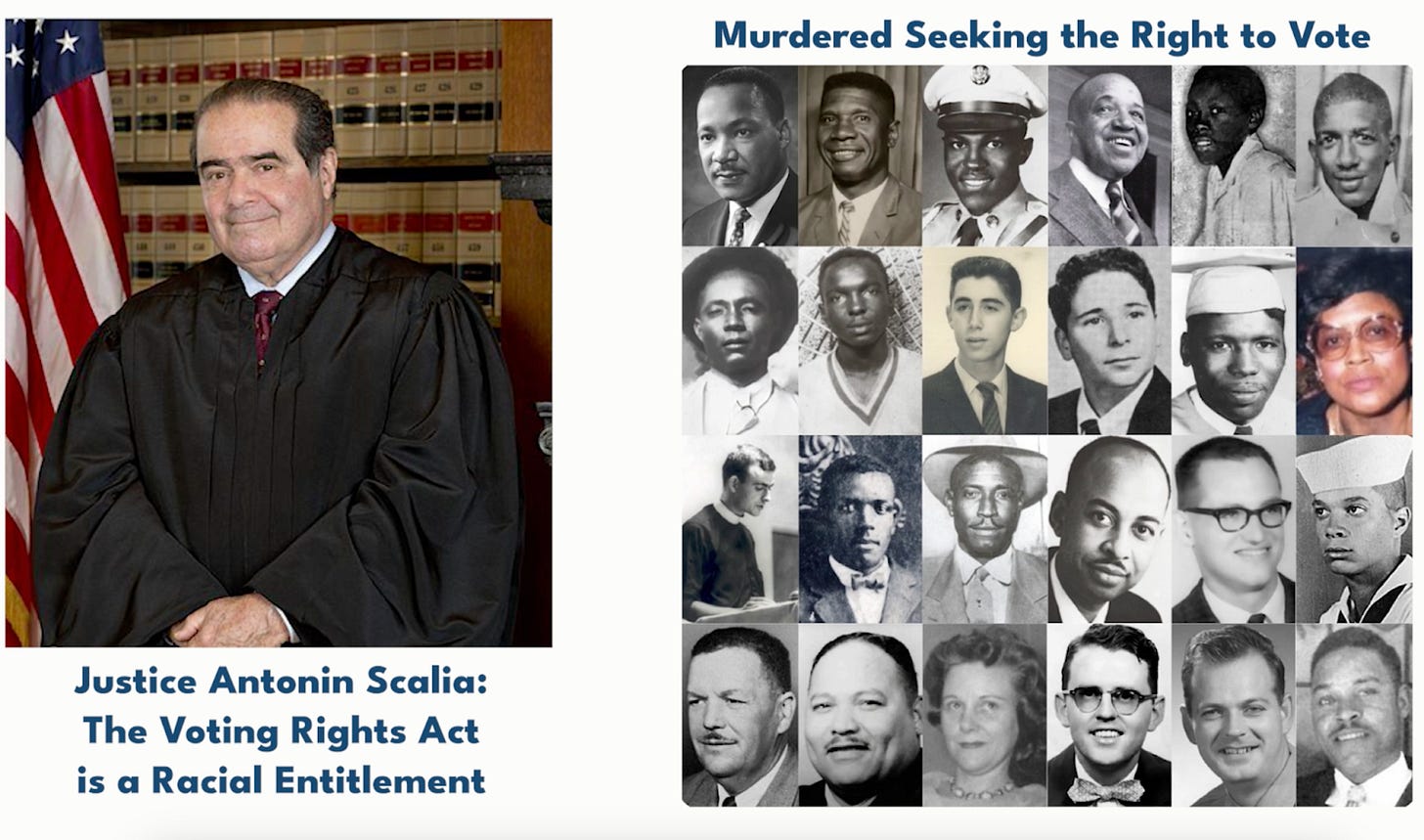
Now, take just one minute to watch the video below, listen to Scalia say those words, and imagine the lives, friends, and families of each one of these civil rights leaders who were murdered to win that “racial entitlement”—the long march to securing their most fundamental rights as Americans.
We should have known that day in 2013 that America’s second reconstruction was still too fragile to be left to the lawyers. But we pretended otherwise, and have reaped the whirlwind.
Weekend Reading is edited by Emily Crockett, with research assistance by Andrea Evans and Thomas Mande.
As a Substack post, this is necessarily cursory, and to a great extent assumes your familiarity with the highlights of the relevant histories, I’ve added footnotes along the way. Books are mentioned once, although many could be suitable at various points through the post. And, apologies for works I have inadvertently left out due to my desire to get this posted.
For more on this episode, see, for example, Hochschild, Adam, American Midnight: The Great War, a Violent Peace, and Democracy's Forgotten Crisis, Gage, Beverly, G-Man: J. Edgar Hoover and the Making of the American Century
Excellent accounts include: Holder, Eric, Our Unfinished March: The Violent Past and Imperiled Future of the Vote-A History, a Crisis, a Plan, Waldman, Michael, The Fight to Vote, Anderson, Carol, One Person, No Vote: How Voter Suppression Is Destroying Our Democracy, Ifill, Sherrilyn A., On the Courthouse Lawn: Confronting the Legacy of Lynching in the Twenty-first Century, Berman, Ari, Give Us the Ballot: The Modern Struggle for Voting Rights in America, Klinkner, Philip A., Smith, Rogers M., University of Chicago Press, The Unsteady March: The Rise and Decline of Racial Equality in America The Rise and Decline of Racial Equality in America, Foner, Eric, Free Soil, Free Labor, Free Men: The Ideology of the Republican Party before the Civil War, Valelly, Richard M., The Two Reconstructions: The Struggle for Black Enfranchisement
See, for example, Du Bois, W. E. B., Black Reconstruction; Foner, Eric, The Second Founding: How the Civil War and Reconstruction Remade the Constitution; Cox Richardson, Heather, West from Appomattox: The Reconstruction of America after the Civil War
See, for example, Richardson, Heather Cox: The Death of Reconstruction: Race, Labor, and Politics in the Post-Civil War North, 1865-1901 and How the South Won the Civil War: Oligarchy, Democracy, and the Continuing Fight for the Soul of America; Horwitz, Tony, Confederates in the Attic: Dispatches from the Unfinished Civil War
See, for example, Charles Warren, The Supreme Court in United States History: 1856-1918, Cohen, Adam, Supreme Inequality: The Supreme Court's Fifty-Year Battle for a More Unjust America, Hasen, Richard L., The Voting Wars: From Florida 2000 to the Next Election Meltdown, Wang, Tova, Nittoli, Janice, The Politics of Voter Suppression: Defending and Expanding Americans' Right to Vote
See, for example, Blight, David W., Race and Reunion: The Civil War in American Memory, Cox, Christopher, Woodrow Wilson: The Light Withdrawn
See, for example, Blight, David W., Frederick Douglass: Prophet of Freedom, Oakes, James, The Scorpion's Sting: Antislavery and the Coming of the Civil War, Oakes, James, The Crooked Path to Abolition: Abraham Lincoln and the Antislavery Constitution
See, for example, Goldfield, Michael, The Southern Key: Class, Race, and Radicalism in the 1930s and 1940s, Gilmore, Glenda Elizabeth, Defying Dixie: The Radical Roots of Civil Rights, 1919-1950
See, for example, Katznelson, Ira, Black Men, White Cities: Race, Politics, and Migration in the United States, 1900-30 and Britain, 1948-68
See, for example, Honey, Michael K., Southern Labor and Black Civil Rights: Organizing Memphis Workers
See, for example: Schickler, Eric, Racial Realignment: The Transformation of American Liberalism, 1932-1965 (Princeton Studies in American Politics: Historical, International, and Comparative Perspectives Book 153); Frymer, Paul, Uneasy Alliances: Race and Party Competition in America; Haines, Herbert H., Black Radicals and the Civil Rights Mainstream, 1954-1970; Horne, Gerald, International Publishers Co., Inc. Communist Front? The Civil Rights Congress: 1946-1956; Frederickson, Kari, Cold War Dixie: Militarization and Modernization in the American South and The Dixiecrat Revolt and the End of the Solid South, 1932-1968
See, for example, America in the King Years, Taylor Branch’s three-volume biography of Martin Luther King
See, for example, Marable, Manning, Race, Reform, and Rebellion: The Second Reconstruction and Beyond in Black America, 1945-2006, Third Edition; Mickey, Robert, Paths Out of Dixie: The Democratization of Authoritarian Enclaves in America's Deep South, 1944-1972
See, for example, Reed, Adolph L., The South: Jim Crow and Its Afterlives, Kousser, J. Morgan., Yale Univ Pr, The Shaping of Southern Politics: Suffrage Restriction and the Establishment of the One-Party South, 1880-1910
Until Goldwater, the national Republicans were as or more committed to addressing civil rights as Democrats were. Nixon formalized the Republican Party’s commitment to those opposed to racial progress with his Southern Strategy in 1968. And, later, Lee Atwater said the quiet part out loud.
See, for example, Lawrence Goldstone, Inherently Unequal: The Betrayal of Equal Rights by the Supreme Court, 1865-1903
Technical note - the chart is based on control in each presidential election year beginning in 1932. It was not worth the effort to gain the precision to mark dates for state legislatures that are elected in odd years since doing so would not change the conclusion. Also, note that the charts reflect who controlled the legislatures in the election year, not who won the election that year.
See, for example, Black, Earl, Black, Merle, The Rise of Southern Republicans.
Wilson, Woodrow, Division and Reunion, 1829-1889

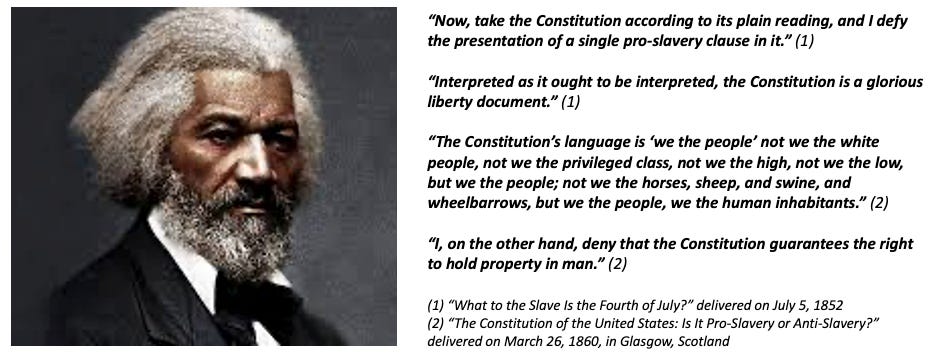
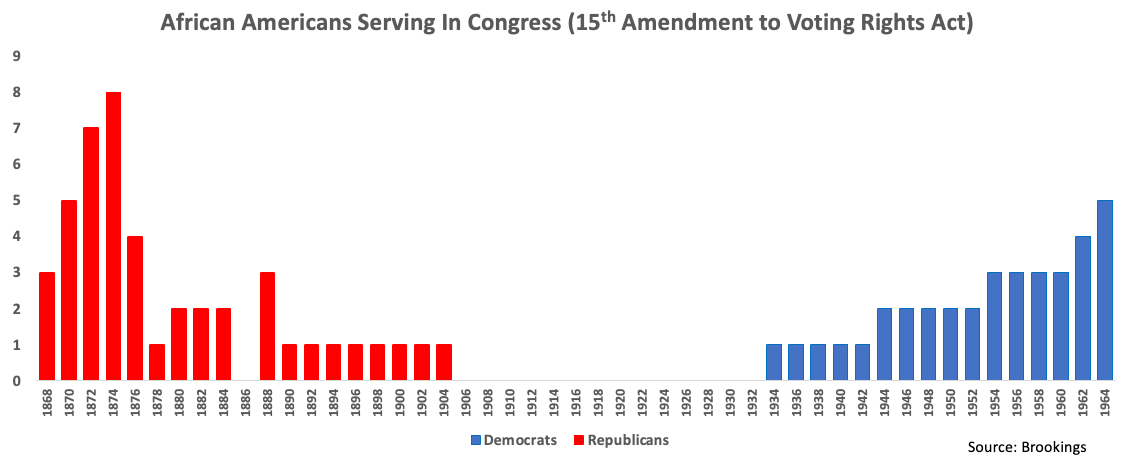
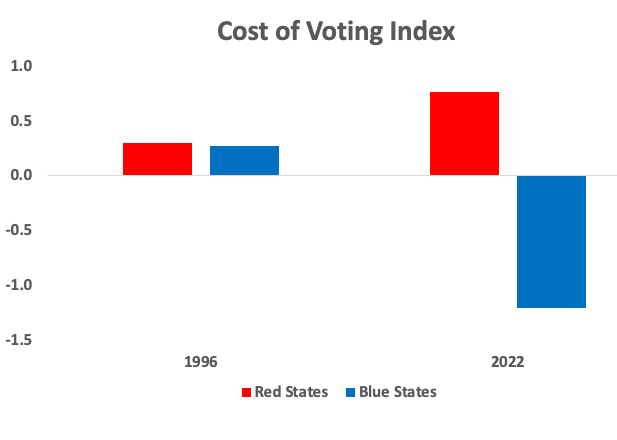
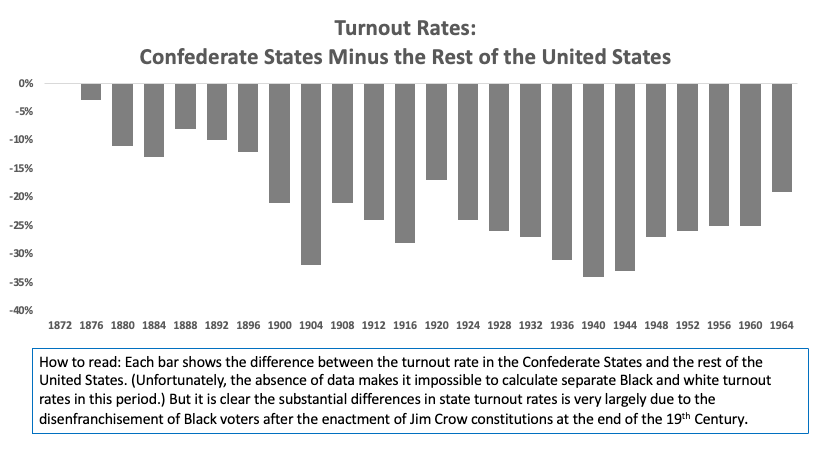
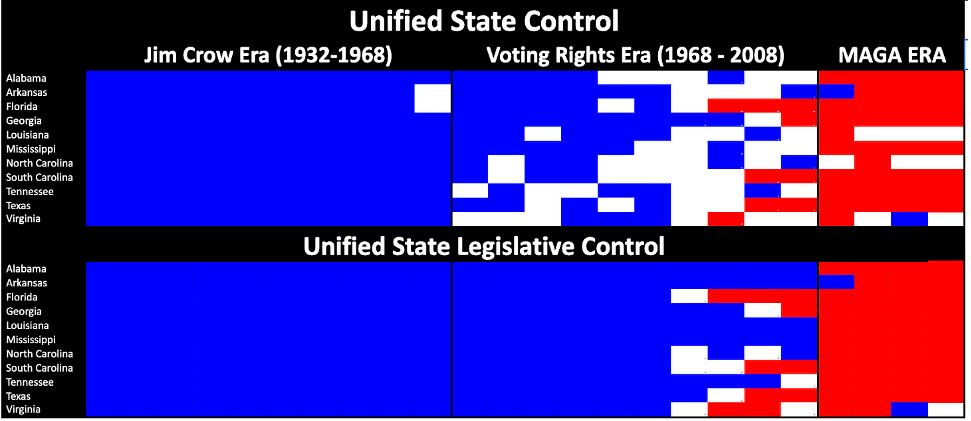
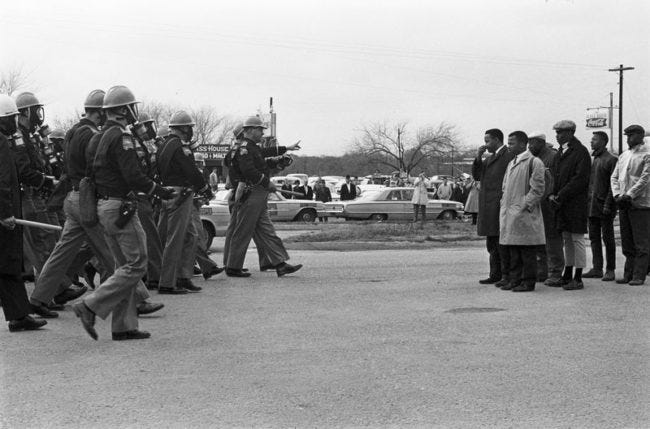

No comments:
Post a Comment